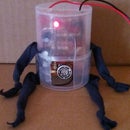Introduction: Touch Buzzer
In this Instructable you will be building a touch buzzer.
A cheap circuit is explained in this Instructable:
https://www.instructables.com/id/Cheap-Touch-Buzze...
You can also implement this circuit with a MOSFET. However, a MOSFET transistor could be more expensive. Also, finding flows in a MOSFET circuit could be a challenge if you lack experience due to high gain and high input resistance of MOSFETs.
Supplies
You will need:
- buzzer or electric bell,
- small matrix board,
- electric drill,
- soldering iron (optional - you can twist the wires together),
- solder (optional),
- old food container or cardboard/plastic box,
- switch, - sticky tape,
- blue tack,
- old packaging materials,
- a few general purpose NPN BJT and PNP BJT transistors,
- NPN BJT power transistor,
- heat sink,
- heat transfer compound,
- metal wire (1 mm),
- thin electrical wires,
- a few bolts, washers and nuts (for heat sink connection and touch terminals),
- screw driver,
- pliers.
Step 1: Attach Transistor
Squeeze heat transfer paste onto the heat sink. Do not put as much as I did.
Screw in the power transistor to heat sink.
Step 2: Attach Transistor to Matrix Board
Use electric drill to drill two holes for the heat sink and insert the heat sink into holes.
You can use solder or metal wire to secure the heat sink and transistor to matrix board.
Step 3: Build the Circuit
The first circuit, a simpler schematic that you see is the best option. There is a high chance that it will work.
The diode is an optional if your buzzer or electric bell conducts current in both directions, when the two terminals are switched. Do switch the terminals of the buzzer if it has a + sign at one of the terminals. You might burn the buzzer. There could be a voltage regulator inside that is not be able to sustain reverse biasing. However, if your buzzer is an old fashioned electric bell then you can definitely switch terminals. You will need the optional diode shown in the circuit because the old fashioned electric bell is an inductive load and might feed high current during discharge phase of oscillation cycle.
You implement the second schematic to solve the following issues with the circuit not working:
1. Buzzer is not turning on when I touch the terminals:
- Increase the power supply voltage by reducing the value of variable resistor. Transistors usually have higher current gains at higher supply current values. This is why you should increase the voltage.
- Add additional transistor (fourth transistor) to the circuit if increasing the voltage does not help.
2. Buzzer is on all the time:
- Add power supply filters that are shown. The cut-off frequency is 1/(2*pi*Rs1*Cs1).
- Add filters in between cascaded amplifiers. The cut-off frequency is 1/(2*pi*Rb1B*Cb1).
Step 4: Build the Base
Use sticky tape to build the base from old packaging materials.
Step 5: Attach Circuit to Base
Use blue tack to attach circuit to base.
Step 6: Attach Switch and Touch Terminals
Connect bolts and nuts.
Secure the wires with metal wire because bending of the wires when you open the lid will lead to wire breakage.
You are now done!
Please watch this video of the device working.

Participated in the
Pocket Sized Contest











